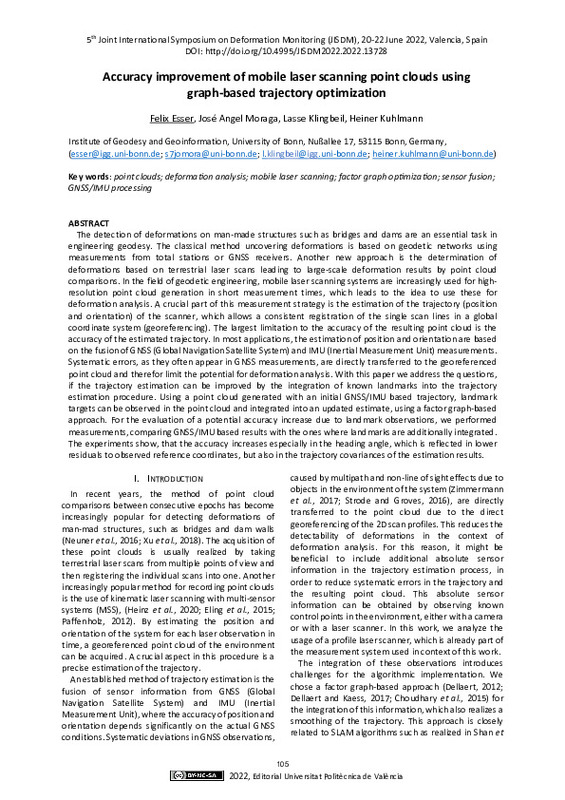JavaScript is disabled for your browser. Some features of this site may not work without it.
Buscar en RiuNet
Listar
Mi cuenta
Estadísticas
Ayuda RiuNet
Admin. UPV
Accuracy improvement of mobile laser scanning point clouds using graph-based trajectory optimization
Mostrar el registro sencillo del ítem
Ficheros en el ítem
| dc.contributor.author | Esser, Felix
|
es_ES |
| dc.contributor.author | Moraga, José Angel
|
es_ES |
| dc.contributor.author | Klingbeil, Lasse
|
es_ES |
| dc.contributor.author | Kuhlmann, Heiner
|
es_ES |
| dc.date.accessioned | 2023-03-06T11:59:08Z | |
| dc.date.available | 2023-03-06T11:59:08Z | |
| dc.date.issued | 2023-01-27 | |
| dc.identifier.isbn | 9788490489796 | |
| dc.identifier.uri | http://hdl.handle.net/10251/192341 | |
| dc.description.abstract | [EN] The detection of deformations on man-made structures such as bridges and dams are an essential task in engineering geodesy. The classical method uncovering deformations is based on geodetic networks using measurements from total stations or GNSS receivers. Another new approach is the determination of deformations based on terrestrial laser scans leading to large-scale deformation results by point cloud comparisons. In the field of geodetic engineering, mobile laser scanning systems are increasingly used for high-resolution point cloud generation in short measurement times, which leads to the idea to use these for deformation analysis. A crucial part of this measurement strategy is the estimation of the trajectory (position and orientation) of the scanner, which allows a consistent registration of the single scan lines in a global coordinate system (georeferencing). The largest limitation to the accuracy of the resulting point cloud is the accuracy of the estimated trajectory. In most applications, the estimation of position and orientation are based on the fusion of GNSS (Global Navigation Satellite System) and IMU (Inertial Measurement Unit) measurements. Systematic errors, as they often appear in GNSS measurements, are directly transferred to the georeferenced point cloud and therefor limit the potential for deformation analysis. With this paper we address the questions, if the trajectory estimation can be improved by the integration of known landmarks into the trajectory estimation procedure. Using a point cloud generated with an initial GNSS/IMU based trajectory, landmark targets can be observed in the point cloud and integrated into an updated estimate, using a factor graph-based approach. For the evaluation of a potential accuracy increase due to landmark observations, we performed measurements, comparing GNSS/IMU based results with the ones where landmarks are additionally integrated. The experiments show, that the accuracy increases especially in the heading angle, which is reflected in lower residuals to observed reference coordinates, but also in the trajectory covariances of the estimation results. | es_ES |
| dc.description.sponsorship | Funding: This work was funded by the Deutsche Forschungsgemeinschaft (DFG, German Research Foundation) under Germany’s Excellence Strategy–EXC 2070–390732324. | es_ES |
| dc.format.extent | 8 | es_ES |
| dc.language | Inglés | es_ES |
| dc.publisher | Editorial Universitat Politècnica de València | es_ES |
| dc.relation.ispartof | 5th Joint International Symposium on Deformation Monitoring (JISDM 2022) | |
| dc.rights | Reconocimiento - No comercial - Compartir igual (by-nc-sa) | es_ES |
| dc.subject | Point clouds | es_ES |
| dc.subject | Deformation analysis | es_ES |
| dc.subject | Mobile laser scanning | es_ES |
| dc.subject | Factor graph optimization | es_ES |
| dc.subject | Sensor fusion | es_ES |
| dc.subject | GNSS/IMU processing | es_ES |
| dc.title | Accuracy improvement of mobile laser scanning point clouds using graph-based trajectory optimization | es_ES |
| dc.type | Capítulo de libro | es_ES |
| dc.type | Comunicación en congreso | es_ES |
| dc.identifier.doi | 10.4995/JISDM2022.2022.13728 | |
| dc.relation.projectID | info:eu-repo/grantAgreement/DFG//EXC 2070–390732324 | es_ES |
| dc.rights.accessRights | Abierto | es_ES |
| dc.description.bibliographicCitation | Esser, F.; Moraga, JA.; Klingbeil, L.; Kuhlmann, H. (2023). Accuracy improvement of mobile laser scanning point clouds using graph-based trajectory optimization. En 5th Joint International Symposium on Deformation Monitoring (JISDM 2022). Editorial Universitat Politècnica de València. 105-112. https://doi.org/10.4995/JISDM2022.2022.13728 | es_ES |
| dc.description.accrualMethod | OCS | es_ES |
| dc.relation.conferencename | 5th Joint International Symposium on Deformation Monitoring | es_ES |
| dc.relation.conferencedate | Junio 20-22, 2022 | es_ES |
| dc.relation.conferenceplace | València, España | es_ES |
| dc.relation.publisherversion | http://ocs.editorial.upv.es/index.php/JISDM/JISDM2022/paper/view/13728 | es_ES |
| dc.description.upvformatpinicio | 105 | es_ES |
| dc.description.upvformatpfin | 112 | es_ES |
| dc.type.version | info:eu-repo/semantics/publishedVersion | es_ES |
| dc.relation.pasarela | OCS\13728 | es_ES |
| dc.contributor.funder | Deutsche Forschungsgemeinschaft | es_ES |








